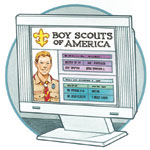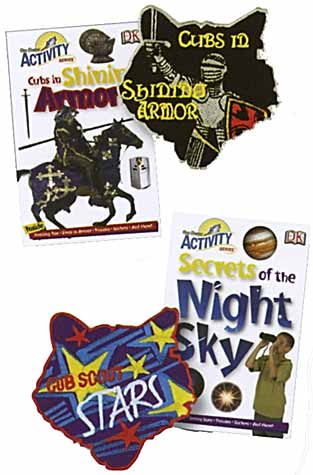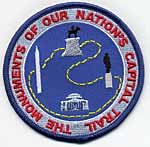
News Briefs
Enter the Boys' Life reading contest
Young readers have two months left to enter the 2006 Boys' Life "Say Yes to Reading!" contest. Entrants write a report of 500 words or less in their own words on "The Best Book I Read This Year." Books can be fiction or nonfiction. Enter reports in one of three age categories: 8 years old and younger; 9 and 10 years old; 11 years and older.
The contest is open to all Boys' Life readers. All entrants receive a free Pedro patch—but only if they include a business-size, stamped (39 cents), self-addressed envelope with their report. (Include name, address, age, and school grade with each book report.)
First-place winners in each age category will receive a $100 gift certificate good for any product in the BSA Official Retail Catalog. Second-place winners will receive a $75 gift certificate, and third-place winners, a $50 certificate.
Send reports and stamped return envelopes for the free patch to Boys' Life Reading Contest, S306, P.O. Box 152079, Irving, TX 75015-2079. Entries must be postmarked by Dec. 29, 2006.
Apply for National Eagle Scout Association scholarships
Eagle Scouts who are graduating high school seniors and will attend an accredited college or university that awards at least a bachelor's degree may qualify for a scholarship awarded by the National Eagle Scout Association (NESA).
Candidates must have received the Eagle Scout Award before applying, demonstrated leadership ability in Scouting and strong participation in activities outside Scouting, and achieved an SAT and/or ACT score acceptable by the standards set by the review committee.
Available scholarships include:
- Mabel and Lawrence S. Cooke Scholarships (Form 58-702C)—one $48,000 scholarship (up to $12,000 per year) and four $20,000 scholarships ($5,000 a year for four years). Applicants must demonstrate financial need and have the endorsement of a volunteer or professional Scout leader who knows them personally.
- National Eagle Scout Scholarship Fund (Form 58-702C)—Scholarships provided vary each year, depending on the funds available.
- Hall-McElwain Merit Scholarships (Form 58-714B)—Based on merit, these are open to high school seniors through their undergraduate junior year in college. The number of scholarships available varies annually depending on funds available.
Applications will be available on the NESA Web site at www.nesa.org; at local Scout council service centers; or from NESA, 1325 W. Walnut Hill Ln., P.O. Box 152079, Irving, TX 75015-2079.
Scholarship applications must be postmarked after Oct. 1, 2006, but no later than midnight Jan. 31, 2007.
Numbers
29—years the Meherrin District in the Heart of Virginia Council has hosted an annual Wilderness Weekend. The 2006 event, held during the Memorial Day weekend at the council's Camp Eagle Point, was attended by troops from the Meherrin and Weyanoke Districts as well as other units from the greater Richmond area. The program featured activities from wilderness survival skills to black-powder shooting to a regatta raft race, in which units built rafts using only lashings.
90—number of years for anniversary celebrated in 2006 by the Cascade Pacific Council in Portland, Ore. Founded in July 1916, a month after the BSA received its congressional charter, the council was first known as the Portland Council. After mergers with a number of other councils, it now serves a much larger area. A booklet with a short history and photographs can be downloaded from the council Web site, www.cpcbsa.org.
246—Webelos Scouts who attended last November's fifth annual Webelos Activity Day, hosted in Shoreview, north of St. Paul, Minn., by the Northern Star Council's Northwest District. Boys could earn the Artist, Engineer, Scientist, and Showman activity pins by participating in two workshops in the morning and two in the afternoon.
1,200—U.S. flags placed on gravesites of military veterans at the Sunrise Memorial Cemetery in Vallejo, Calif., on Memorial Day by Cub Scouts, Boy Scouts, and Girl Scouts. The Scouts' annual participation, done in conjunction with the local Veterans of Foreign Wars post, started in 2000 when the VFW post realized it didn't have enough members to place all the flags at one time.
10,000—and more books donated by Chapel Hill, N.C.-area residents in a drive by American Legion Post 6 and Boy Scout Troop 39 (chartered to Chapel Hill's University United Methodist Church) to supply reading materials for U.S. military personnel in Iraq. Scouts and Legionaires boxed the books, loaded them on trucks, and delivered them to nearby Pope Air Force Base for transport to Iraq. "It took three trips to deliver all the books to Pope," reported Troop 39 Scoutmaster Jim Mackorell. "The military was so very appreciative."
 For November's "Cubs in Shining Armor" theme, Den Meeting in a Box has stickers, games, puzzles, a story, and information on armor, coats of arms, and life in medieval Europe. December's Box includes similar fun materials for the "Cub Scout Stars" theme, including instructions for making a lunar calendar and recognizing constellations. |
Here's Help for Den Leaders
Den Meeting in a Box is a new resource available to den leaders for use with each monthly pack theme.
The kits are available for Tiger Cub Scout, Wolf Cub Scout, or Bear Cub Scout meetings. They contain materials (such as craft kits for making decorative hat visors) related to each monthly theme and to the den activities suggested in the meeting plans found in the single-volume Cub Scout 2006-2007 Program Helps (BSA No. 34304B).
Program Helps monthly meeting plans for the immediate coming months are also bound into issues of Scouting magazine (except October) and sent to Cubmasters and assistants, den leaders and assistants, den leader coaches, and commissioners. (A Personal Document Format [PDF] version of the current month's Program Helps can also be downloaded from the BSA national Web site at
www.scouting.org/
cubscouts/resources/34304.)
Den Meeting in a Box kits are available for $37.49 each from local council service centers, Scout shops, www.scoutstuff.org, or from the BSA National Distribution Center, P.O. Box 7143, Charlotte, NC 28241-7143, (800) 323-0732, Fax 704-588-5822.
Centennial Quality Award for 2007-2010
Beginning in 2007 and continuing through 2010, the Centennial Quality Awards program, named in celebration of the 100th anniversary of the Boy Scouts of America, will replace the traditional Quality Awards program for units, districts, and councils.

By focusing on unit leaders working closely with commissioners to set specific goals and then monitoring progress toward them, the new award is designed to have a greater impact on improving the quality of the program in every pack, troop, team, and crew in the BSA.
"The revised award program enables us to salute those who truly deliver exceptional programs to youth members at all levels of the organization," said Keith Christopher, director of Leadership Support Service in the BSA Program Group. "By earning this award, a unit, district, or council makes a statement that they have provided the highest quality program experience possible."

As the first step in achieving the Centennial Quality Award, every unit, district, and council will establish annual goals in key areas of program delivery.
For packs, troops, teams, and crews, the process for 2007 begins late this year or early in 2007 when unit leadership meets with an assigned unit commissioner or a district-level volunteer in consultation with the district executive to complete a commitment form. (The form must be submitted and approved no later than Feb. 15, 2007.)

On the commitment form, unit leaders agree to goals that will indicate sufficient progress in areas such as:
- percentage of leaders completing Fast Start and Basic Leader Training
- number of new youth members and active parents recruited and percentage of youth members retained from the previous year
- unit rechartering on time
- percentage of youth advancing in rank and having an outdoor experience or monthly activity
- conducting a program planning session and carrying out adequate money-earning activities to support that program.

During the year, the unit leader and committee chairman will get together with the unit commissioner for an action planning meeting to evaluate progress toward the commitment form goals.
Using a unit self-assessment process, they will review successes as well as areas needing improvement and determine how the remaining goals can be accomplished and if additional goals need to be added in other areas.
After Oct. 31, 2007, the unit leader, committee chairmen, and unit commissioner can review the total progress made toward each goal and determine if the unit qualifies for Centennial Quality status.
For each year of the award, a recognition patch is available in a different color: 2007, red; 2008, white; 2009, blue; and 2010, red, white, and blue.
Individual members of qualifying Centennial Quality Units wear the appropriate patch in position three on the right sleeve of their uniform (for packs and troops, below the den or patrol emblem).
Unit awards for packs, troops, teams, and crews include a unit ribbon, lapel pins for leaders, and a plaque for each year qualifying.
More information is available from local Scout council service centers or at http://www.scouting.org/awards/centennial.
Web site invites comments for future Scout handbook
Scout leaders, Scouts, and others have an opportunity to share input in the creation of the upcoming 12th edition of The Boy Scout Handbook.
Plans call for the new handbook to be published in early 2010, in conjunction with the 100th anniversary of the Boy Scouts of America.
In the meantime, an online survey at www.scouting.org/boyscouts/survey allows individuals to comment on such concerns as what new topics should be covered in the next handbook and what parts of the current handbook should not be continued.
Survey participants can also make suggestions on writing and visual styles, photography and illustrations, the book's physical characteristics, and other topics.
A monumental experience
On a visit to Washington, D.C., in 2002, the Metz family of Cedar Lake, Ind.—dad Bruce, mom Valerie, and sons Paul, 18, Jason, 16, and Andrew, 14—stopped at many major tourist attractions, such as the U.S. Capitol, the Supreme Court Building, and various memorials.
Along the way, they noticed many statues, monuments, and memorials honoring lesser-known figures from American history.

"My sons considered themselves fairly well studied in history, but they were unfamiliar with such names as Joseph Henry, John Rawlins, and Albert Pike," Bruce Metz recalls. (Henry, 1797-1878, was a scientist who perfected the electromagnet and served as the first secretary of the Smithsonian Institution; Rawlins, 1831-1869, was an advisor to Gen. U. S. Grant; and Albert Pike, 1809-1881, a man of many careers, was the sole Confederate officer to end up with a statue in his honor in Washington, D.C.) "They recognized names like [Tadeusz] Kosciuszko, [Baron Friedrich Wilhelm] von Steuben, and [John] Ericsson, but were not certain as to their place in history. And they were curious about the reason for others, such as the marble monument to President Franklin D. Roosevelt in front of the National Archives." (Polish-born Kosciuszko, 1746-1817, served America in the Rev�olutionary War, as did Prussian-born von Steuben, 1730-1794. Shipbuilder Ericsson, 1803-1889, designed the Civil War ironclad, U.S.S. Monitor.)
Unable to readily find information on these statues and memorials, the family hit upon the idea of developing a 10-mile trail that would take hikers to more than 55 sites on or close to the National Mall. They also decided to write a guidebook with information about each stop on the route.
The trail was designed with Scouting in mind, to be at least 10 miles, "suitable for a one-day Scout outing," Bruce Metz says, and useful for fulfilling several of the Hiking merit badge requirements. (At the time of their Washington visit, Jason and Paul were Eagle Scouts and Andrew was on track to become an Eagle two years later. Bruce served as an assistant Scoutmaster and Valerie as a committee member for their sons' troop.)
"In the spring of 2003, we made another trip to Washington to review the proposed route," Bruce says. And on additional, separate trips, Bruce and Paul took photographs of the monuments for the guidebook.
Valerie served as the book's primary editor, reading the text numerous times, finding and correcting errors.
By December 2004, the trail was complete—a loop that officially begins and ends at the Ellipse (also known as President's Park South, between the White House and the Washington Monument at 17th Street and Constitution Avenue, NW) but that can be started and finished at any point.
The route extends to the Capitol Building in the east, the Lincoln Memorial in the west, the Jefferson Memorial in the south, and two blocks beyond the White House in the north.
In addition to opening the trail, the family published the 77-page A Guide to The Monuments of Our Nation's Capital Trail. The guidebook includes a trail map, photographs and information about each memorial, and "Did You Know" segments with interesting and unusual facts about a monument or the individual being honored.
The family also designed an embroidered patch, which is available for purchase by individuals who hike all or a portion of the trail.
The first Scout troops hiked the trail in the spring of 2005, and the BSA added it to its Nationally Approved Historic Trails list.
That summer a number of troops from around the nation hiked the trail before or after the 2005 National Scout Jamboree. Nearly 600 hikers from jamboree troops ordered a trail patch.
"We were able to really learn about some of the individuals associated with our country's history," Ray Congdon, Scoutmaster of Jamboree Troop 741 from Tacoma, Wash., reported to Bruce Metz after his Scouts hiked a portion of the trail. Had it not been for the guidebook, Congdon said, "I'm not sure our troop would have taken any time to learn about these monuments."
For more information on the trail or the guidebook, contact tmoonct@yahoo.com.
November - December 2006 Table of Contents
Copyright © 2006 by the Boy Scouts of America. All rights thereunder reserved; anything appearing in Scouting magazine or on its Web site may not be reprinted either wholly or in part without written permission. Because of freedom given authors, opinions may not reflect official concurrence.